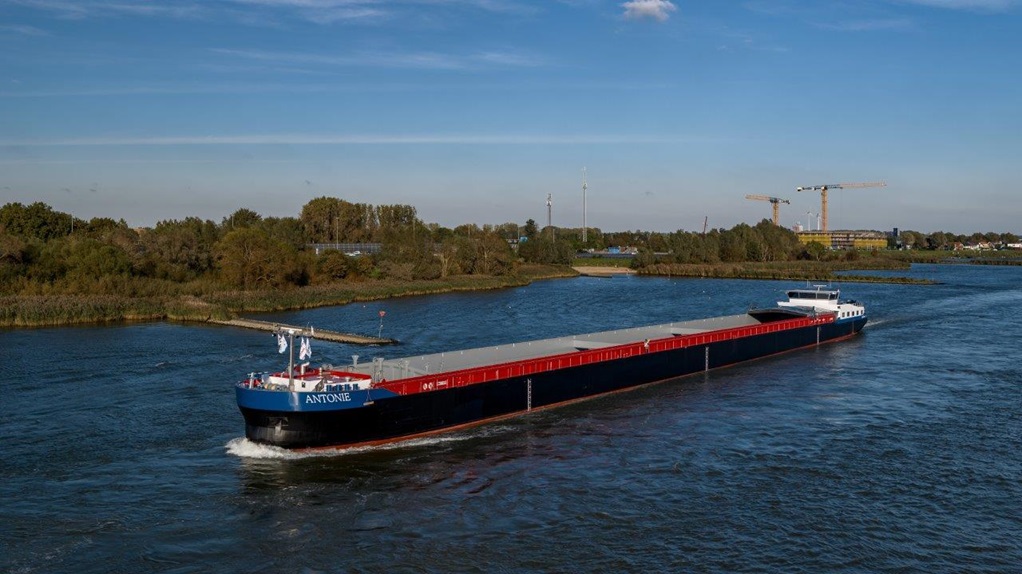Lenten Scheepvaart (the Netherlands) will go down in history as the owner of the world’s first-ever newbuild hydrogen-powered inland shipping barge. With this, the shipping company sets a new standard. An important step towards zero-emission transport on Dutch inland waterways. The Hydrogen Electric Cargo Ship ‘Antonie’ (WEVA) was realised by Concordia Damen. On 23 October the technical sea trials were held, during which the ship was inspected by Lloyds Register and received a provisional certificate to be put into service.
Bart van Driel, project manager at Concordia Damen, was there. With the hydrogen containers, expected to arrive by the end of this year, not yet installed on board, full attention could be given to testing the advanced diesel-electric propulsion system.
Van Driel: The fuel cell will soon serve as an energy supplier for the battery packs after the installation of the distribution panel and the placement of the hydrogen containers. The fuel cell itself, which converts hydrogen into electricity, has already been installed on board.
Once the distribution panel is delivered, it is just a matter of sizing and manufacturing the final pieces of piping and adjusting the fuel cell installation itself. The diesel generator will then no longer be used, so the Antonie will sail completely emission-free.
Pieter Baggerman, Naval Architect at Concordia Damen and closely involved in the innovative ship design: We look forward to the Antonie being able to sail her first fully emission-free miles before the end of the year.
Full circular chain
The dry cargo vessel will transport salt for Nobian, European leader in the production of essential chemicals for various industries. For years, Lenten Scheepvaart has been shipping salt from Delfzijl to the Nobian plant in the Botlek. The company turns this salt into chlor-alkali, among other things, with hydrogen as a residual product. The hydrogen produced in the chlor-alkali production process will soon form the clean fuel for the Antonie. A textbook example of a circular chain. With three hydrogen containers on board, Ms Antonie will soon have enough energy available for full zero-emission transport between Delfzijl-Rotterdam-Delfzijl. A hydrogen bunker station has now been built in Delfzijl with a subsidy.
Sustainable inland navigation vessels
Concordia Damen has built up a considerable portfolio when it comes to building sustainable inland waterway vessels. Several maritime awards awarded to them and to their customers testify to the drive to keep innovating and pushing the boundaries of what is possible.
The WEVA project is a joint effort by Concordia Damen Shipbuilding in collaboration with CCM3, Nedstack Fuel Cell Technology, Nobian, Energy TransStore, NRPC and client Lenten Scheepvaart, among others. Its realisation has been made possible in part by a grant from the Dutch Ministry of Infrastructure and Water Management.
Update: Royal visit
On Tuesday 14 November, His Majesty the King visited the Antonie in Duisburg. The King planned this visit as part of an informative and economic hydrogen mission to Germany and was informed bout/by hydrogen-related organisations in North Rhine-Westphalia and the RH2INE network, among other things.
Source: Concordia Damen.
Tags: Concordia Damen, Hydrogen, Shipping Vessel, Trial run



Recent Posts
DNV Grants Approval in Principle for New Ammonia Bunkering Vessel Design
Proteus Launches Modular Hydrogen Fuel Cell System for Maritime Sector
Van Oord Unveils Boreas, World’s Largest and Most Sustainable Offshore Wind Installation Vessel
New methanol-fuelled vessel ‘Berlin Maersk’ to enter service
NMPA wins greentech global environment award
CMA CGM in negotiations with Indian shipyards for LNG-powered shipbuilding
L&T to Develop Green Hydrogen and Ammonia Projects in Kandla
Pan Ocean Orders Two Eco-Ready VLCCs from HD Hyundai Heavy Industries